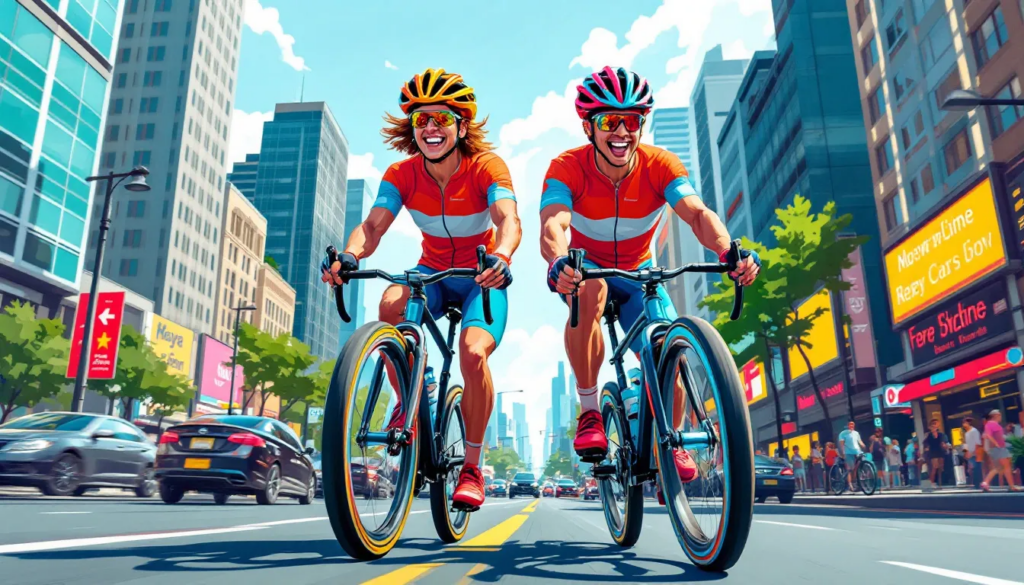Is riding two abreast legal and safe? This article answers these questions and offers practical guidelines. Understand the laws, safety benefits, and tips for riding two abreast.
Key Takeaways
Riding two abreast enhances visibility for cyclists, improving safety by making them more noticeable to motorists and reducing accident risks.
Legal regulations regarding riding two abreast vary by region, with cyclists needing to be aware of local laws to ride responsibly and avoid obstructing traffic.
Effective communication and adherence to safety guidelines, such as transitioning to single file in busy areas, are essential for maintaining safety and promoting respectful road sharing between cyclists and motorists.
Understanding Riding Two Abreast

Riding two abreast is a common practice among cyclists that signifies camaraderie and partnership while cycling. This practice involves two cyclists riding side by side, creating a formation that enhances their visibility and fosters a sense of community among riders. This practice creates a safer environment and promotes group cohesion during rides. Think of it as a dance, where each cyclist is in sync with the other, moving together in harmony and solidarity.
The concept of riding two abreast also highlights the importance of mutual respect among road users. Cyclists riding two abreast are more noticeable to drivers, leading to safer interactions and fewer accidents.
This practice is particularly important during group rides, where maintaining a cohesive and visible formation can significantly enhance the safety of all participants. Understanding the legal aspects and practical guidelines ensures this practice is carried out responsibly.
Legal Aspects of Riding Two Abreast

The legal landscape of riding two abreast can be complex due to varying laws between jurisdictions. In many places, such as California, cyclists are legally allowed to ride two abreast as long as they do not obstruct traffic. Adhering to local bike laws is crucial for cyclists who wish to ride two abreast responsibly. Knowing your rights and respecting rules ensures safety for all road users.
Many believe that riding two cyclists side by side is illegal, but this often stems from a misunderstanding of the laws. The legality of this practice is contingent upon specific conditions, such as not obstructing traffic, which must be respected to avoid conflicts.
The following subsections will delve deeper into the specific bike laws and highway codes, as well as the variations in legislation across different regions.
Bike Law and Highway Code Compliance
Riding two abreast is legal according to Rule 66 of the Highway Code, which indicates that it can be a safe practice. The statement “never ride more than two abreast” leads to ambiguity, as it does not explicitly state that riding two abreast is legal. This ambiguity can cause confusion among both cyclists and drivers. Rule 154 provides further guidelines for riding in pairs, particularly on rural roads, ensuring that cyclists maintain a safe distance from each other and from other road users.
Recent revisions to the Highway Code, effective from January 29, aim to improve cyclist safety by providing clearer guidelines. These changes are expected to foster a better understanding among motorists and cyclists, leading to safer interactions on the road. Adhering to these rules ensures responsible and legal riding while enhancing safety and visibility on the road.
Variations Across Regions
The legal aspects of riding two abreast can vary significantly across different regions. For instance, European countries like France, Italy, and Spain have successfully implemented models where cyclists and motorists share the road harmoniously, promoting safety. These countries have specific laws and attitudes towards riding two abreast, which can affect the safety and rights of cyclists. Cyclists who travel or participate in international events must understand these regional variations.
Local cycling communities can adopt successful practices observed in other countries to improve road sharing and cyclist safety. Communities can enhance their cycling culture and promote safer interactions by learning from these international models. This approach not only benefits cyclists but also contributes to a more harmonious and respectful road-sharing environment for all users.
Safety Benefits of Riding Two Abreast

Riding two abreast offers several safety benefits that make it a preferred practice among cyclists. One of the primary advantages is enhanced visibility. Cyclists riding side by side are more conspicuous to drivers, which can significantly reduce the incidence of unsafe passing by vehicles. Increased visibility makes it easier for drivers to notice and safely overtake cyclists, reducing accident risks.
Another critical safety benefit is the protective barrier that the two-abreast formation provides. This formation acts as a buffer against potential collisions, enhancing cyclist safety on the road.
The following subsections will delve deeper into the specific safety benefits of improved visibility and the naturally protective formation that riding two abreast offers.
Improved Visibility
By riding side by side, cyclists are more likely to be noticed by drivers, reducing the risks of accidents. The side-by-side position enhances their visibility, helping both cyclists and drivers to be more aware of each other’s presence on the road. Improved visibility is particularly beneficial during group rides, clarifying the presence of multiple cyclists more effectively.
Riding two abreast reduces the overall length of the group, making overtaking easier and safer for vehicles. This formation allows quicker passing, minimizing time in the oncoming traffic lane and reducing collision risks. In several European nations, this practice is not only legal but encouraged as a means to enhance safety during overtaking.
Naturally Protective Formation
The two-abreast formation provides a naturally protective barrier for cyclists against motor vehicles and oncoming traffic. This formation allows cyclists to shield each other from potential collisions, creating a safer riding environment. Additionally, riding two abreast can improve traffic flow by allowing vehicles to pass safely when conditions permit.
Cyclists should transition to single file when approaching bends or narrow roads for smoother passage and better maneuverability. This flexibility helps maintain safety while accommodating traffic flow as riding round bends cyclists ride.
Overall, the two-abreast formation enhances cyclists’ safety by providing visibility and protection while also promoting a cooperative spirit on the road.
Practical Guidelines for Riding Two Abreast

Riding two abreast can significantly enhance cyclists’ visibility and safety, but it requires adherence to certain practical guidelines. Cyclists should maintain a consistent and safe distance to enhance stability and prevent accidents. During group rides, riding two abreast fosters camaraderie and facilitates easier communication among cyclists.
Cyclists must ensure they are not obstructing traffic and are traveling at a normal and reasonable movement speed. The following subsections will provide detailed guidelines on communication among cyclists, navigating narrow or busy roads, and transitioning to single file when necessary.
Communication Among Cyclists
Clear communication during club rides is essential for maintaining safety and predictability, especially in tight formations. Bicyclists are required to signal their intentions when turning or stopping. Establishing roles for ride leaders during club rides is vital for maintaining safety and organization.
Effective communication ensures all riders are aware of potential hazards and can react appropriately. This practice not only enhances the safety of the group but also fosters a sense of community and teamwork among cyclists.
Navigating Narrow or Busy Roads
When navigating narrow or busy roads, cyclists should be mindful and consider riding single file to minimize disruption to other vehicles. In several European nations, infrastructure is designed to encourage cycling, promoting coexistence between cyclists and motorists effectively.
Cyclists should be flexible and ready to adapt their formation based on road conditions. This approach ensures safe road sharing while maintaining visibility and safety for vulnerable road users.
Transitioning to Single File
Cyclists must ride single file if they are causing a delay of five or more vehicles behind them. On narrow or busy roads, switching to single file often facilitates easier overtaking by vehicles.
When approaching narrow roads, cyclists should be prepared to ride single file to avoid obstructing traffic. This practice ensures smoother traffic flow and enhances the safety of both cyclists and motorists on the road.
Addressing Common Myths and Misconceptions
There are several myths and misconceptions surrounding the practice of riding two abreast. One prevalent myth is that cyclists do not contribute to road maintenance costs; however, cyclists pay various taxes that indirectly support road infrastructure. Enhancing mutual respect between cyclists and motorists can lead to safer road interactions and reduce conflicts.
Addressing these misconceptions promotes a better understanding of cyclists’ rights and responsibilities. The following subsections will debunk the road tax myth and address concerns about cyclists impeding traffic.
The Road Tax Myth
The commonly referenced ‘road tax’ is actually a tax on vehicle emissions, and since bicycles emit no pollutants, they are not subject to this tax. The term ‘road tax’ often leads to misunderstandings about cyclists’ financial contributions to road maintenance. This means cyclists are exempt from paying a tax that does not apply to them, emphasizing their rights and responsibility to use the road.
Misconceptions about ‘road tax’ lead to unfounded beliefs about cyclists’ contributions and rights on the road. Clarifying this myth fosters a more respectful and cooperative attitude among road users.
Impeding Traffic Concerns
Riding two abreast enhances visibility, making cyclists more noticeable to motorists and reducing accident risks. When navigating narrow or busy roads, cyclists should be mindful and consider riding single file to minimize the disruption to other vehicles.
Cyclists should transition to single file in heavy traffic or to allow vehicles to pass safely. This practice ensures smoother traffic flow and enhances the safety of both cyclists and motorists on the road.
Promoting Respectful Road Sharing
Mutual respect on the roads is essential for the safety and enjoyment of all users, especially cyclists. Countries like France, Italy, and Spain demonstrate a culture of mutual respect between cyclists and drivers, highlighting successful coexistence on the roads. Fostering a cooperative spirit among cyclists and drivers enhances road-sharing practices.
The following subsections will discuss the importance of educating car drivers and club ride etiquette in promoting respectful road sharing.
Educating Car Drivers
Riding two abreast increases cyclists’ visibility to car drivers, reducing the risk of accidents. The two abreast formation provides a protective barrier for cyclists against motor vehicles and oncoming traffic. Promoting the benefits of riding two abreast reduces road rage by fostering understanding of cyclists’ practices.
Educating drivers about cyclists’ legal rights and safety benefits of riding two abreast promotes more respectful and cooperative road-sharing practices. This understanding can help reduce conflicts and enhance the overall safety of all road users.
Club Ride Etiquette
Ride leaders play a crucial role in setting the pace and ensuring that all cyclists are aware of the route and safety measures. Clear communication during group rides ensures safety and helps avoid accidents. Maintaining a compact group formation enhances visibility for both cyclists and motor vehicle traffic.
Cyclists should adhere to established group ride etiquette to ensure a safe and enjoyable experience for all participants. This includes signaling intentions, maintaining a steady pace, and being considerate of other road users. By following these guidelines, cyclists can foster a sense of community and promote safer road sharing.
International Perspectives on Riding Two Abreast
Different countries have diverse regulations and cultural attitudes toward riding two abreast, influencing cyclist safety and behavior. These differences impact how cyclists navigate roads and interact with other users, affecting overall road safety. Learning from international practices can improve local cycling environments and promote safer interactions.
The following subsections will explore successful European models of coexistence and discuss how local communities can adapt these best practices to enhance road safety and cyclist visibility.
European Models of Coexistence
In several European nations, such as France and Spain, a strong culture of respect between cyclists and drivers is prevalent, promoting safe coexistence on the roads. Cyclists riding two abreast can aid drivers in overtaking more swiftly, as this formation reduces the overall road length occupied by a group of cyclists. Educating on the benefits of riding two abreast reduces misunderstandings and promotes a cooperative attitude among road users.
Countries that encourage two-abreast cycling often experience fewer tensions between cyclists and motorists, demonstrating the efficacy of mutual respect. Adopting similar practices fosters safer and more harmonious road-sharing environments.
Adapting Best Practices Locally
Understanding local cycling dynamics is crucial for effectively adapting international best practices. Engaging with local cyclists reveals unique challenges and opportunities for enhancing road safety and sharing. Familiarity with local bike law and highway codes is essential to ensure that adopted practices comply with legal requirements.
Examining successful cycling models from countries with high compliance and respect can guide local adaptations. Adopting communication and etiquette practices from club rides can help improve local cycling group dynamics and road sharing. By learning from international practices, local communities can develop safer and more effective cycling environments.
Summary
Riding two abreast is not just a matter of legality but a practice that enhances safety, visibility, and community among cyclists. By understanding the legal aspects, cyclists can ensure they are riding responsibly and within the bounds of the law. The safety benefits, including improved visibility and the naturally protective formation, make riding two abreast a valuable practice for group rides and everyday cycling.
Promoting respectful road sharing through education and adherence to etiquette can lead to safer interactions between cyclists and motorists. Learning from international models and adapting best practices locally can further enhance the cycling experience and safety for all road users. By fostering a culture of mutual respect and understanding, we can create safer and more harmonious roads for everyone.
Frequently Asked Questions
Is riding two abreast legal everywhere?
Riding two abreast is not legal everywhere; its legality varies by region. Always check and comply with local cycling laws to stay safe and avoid penalties.
Does riding two abreast improve safety?
Yes, riding two abreast improves safety by enhancing visibility to drivers and creating a protective barrier for cyclists. This practice can help reduce the risk of accidents on the road.
What should cyclists do on narrow or busy roads?
Cyclists should ride single file on narrow or busy roads to reduce disruption to traffic and enhance safety. This approach facilitates smoother movement for both cyclists and vehicles.
Do cyclists contribute to road maintenance costs?
Yes, cyclists do contribute to road maintenance costs indirectly through general taxes like sales and income taxes, despite not paying a specific road tax. This means their presence on the road is still factored into the overall funding for infrastructure.
How can car drivers better share the road with cyclists?
Car drivers can better share the road with cyclists by educating themselves on the legality of riding two abreast and fostering a culture of mutual respect and patience. This understanding is essential for reducing conflicts and ensuring safety for all road users.


